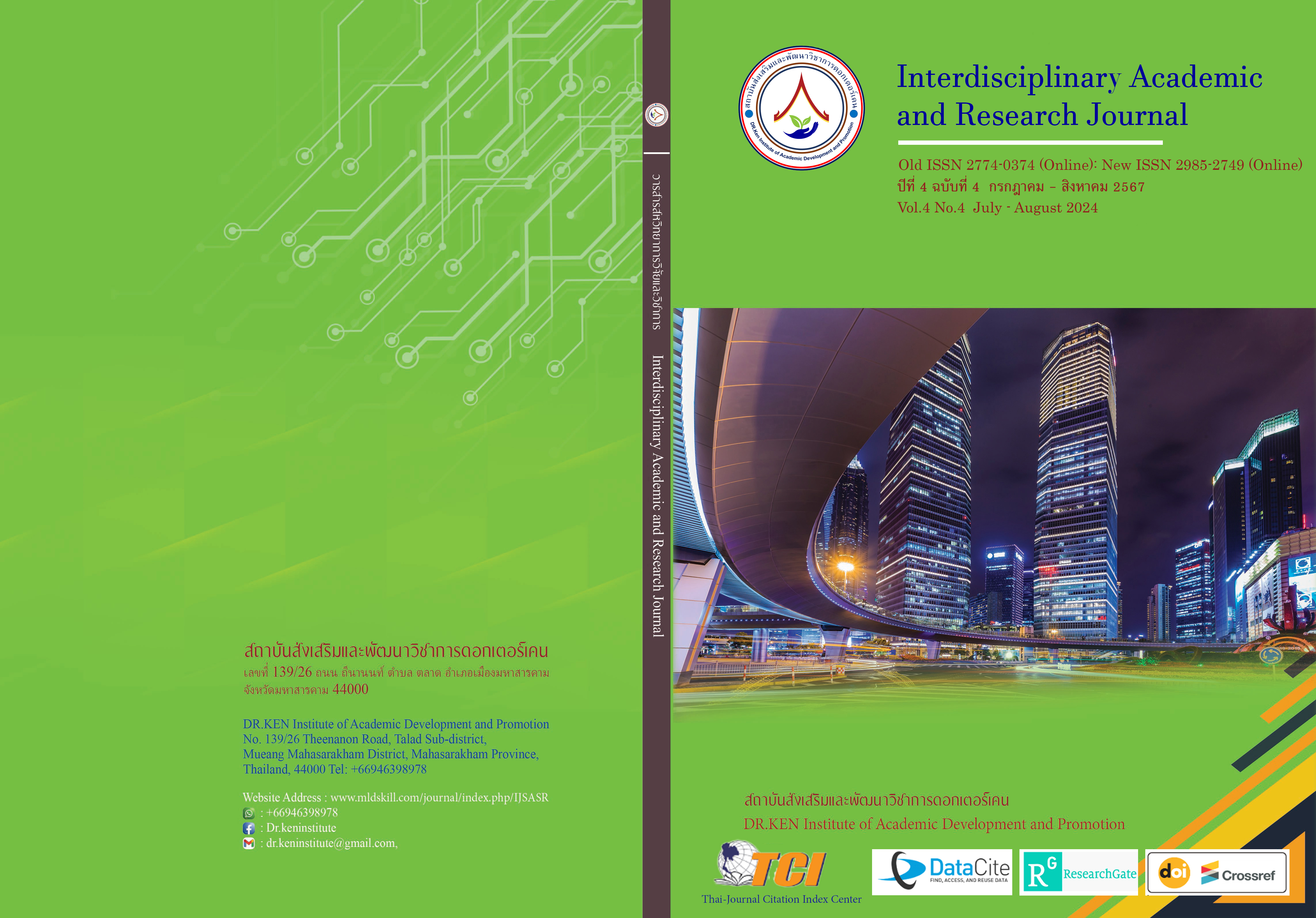A Synthesis of Innovative Research to Improve English Pronunciation Skills of Basic Education Students
DOI:
https://doi.org/10.60027/iarj.2024.277352Keywords:
Research Synthesis;, English Pronunciation Skills;, InnovationAbstract
Background and Aims: Synthesizing innovative research to improve the English pronunciation skills of students at the elementary level. It is a collection of knowledge about using innovations in teaching and a variety of instructional materials to improve English pronunciation skills. In this study, the researcher has synthesized experimental research which is Quantitative Research. Therefore, it will be possible to know the characteristics of the research that result in different values of influence size. The goals of this study were to
1) investigate research characteristics on innovation to improve English pronunciation skills of students at the elementary level and 2) compare research characteristics on the influence size of research related to innovation to develop English pronunciation skills of students at the elementary level.
Methodology: The synthesized research is experimental research that was published in 30 issues between 2013 and 2022 using the Research Characteristics Record form and the Research Quality Assessment form. There was a total of 119 influence sizes obtained. The variables for research characteristics were divided into three categories: publishing and author content, research content, and research methodology.
Results: The research findings were as follows: 1) In terms of research features, (1) publishing and author content it was found that most of the research published in 2018 were researches from Chiang Mai University and Rajabhat Maha Sarakham University. The branch that produced the most was the Curriculum and Instruction branch with a total of 100–150 pages and a total of 50–100 pages excluding appendices. (2) In terms of research content, it was discovered that the research aimed to compare the most. Reading aloud concepts/theories, using two concepts/theories, and the Phonics learning management model are the most commonly used concepts/theories. (3) In terms of research methodology, it was found that most researchers had directional hypotheses with 2 assumptions, 1 dependent variable, and 1 upstream variable. Most of the samples were used in grade 1. The sample size ranged from 11 to 30 people using a purposive random sampling method using the experimental model of the group pretest-posttest design. Most of the research tools used a test and two research tools were used to find the reliability of Kuder–Richardson. The duration of the experiment was 11–20 hours. The t-test dependent statistics were used and most of the research quality assessment results had good quality scores. 2) Regarding the content of the research, it was found that 7 variables could explain the difference in the effect size: 1) research objectives, 2) concepts/theories, 3) the number of concepts/theories, 4) the learning management style, 5) the number of learning management styles, 6) teaching media, and 7) the number of teaching media in research methodology. 9 variables can explain the difference in influence size: 1) Type of hypothesis 2) Number of hypotheses 3) Sample class 4) Sample size 5) Sampling process 6) Research design experimental 7) number of tools 8) experimental period, and 9) type of statistics used.
Conclusion: Learning Management by phonics techniques results in students improved English pronunciation skills of students at the elementary level. The material and teaching equipment variable that has a high effect on student learning is the use of multimedia. or using modern media attracts interest and is appropriate for the age of the students. It will help encourage students to learn.
References
กระทรวงศึกษาธิการ. (2560). หลักสูตรแกนกลางการศึกษาขั้นพื้นฐานพุทธศักราช 2551(ฉบับปรับปรุง 2560). กรุงเทพฯ : โรงพิมพ์สหกรณ์การเกษตรแห่งประเทศไทย จำกัด.
กิติชัย แสนสุวรรณ. (2551). การสังเคราะห์วิทยานิพนธ์ของนิสิต ในหลักสูตรการศึกษามหาบัณฑิต สาขาการบริหารการศึกษา มหาวิทยาลัยมหาสารคาม ระหว่างปี พ.ศ.2538 – 2547. วิทยานิพนธ์ปริญญาการศึกษามหาบัณฑิต. (การบริหารการศึกษา): มหาวิทยาลัยมหาสารคาม.
คัมภีรพจน์ สายเพ็ชร. (2551). การสังเคราะห์งานวิจัยที่เกี่ยวกับการสอนภาษาอังกฤษที่เปรียบเทียบผลสัมฤทธิ์ทางการเรียนระหว่างการใช้นวัตกรรมกับการสอนปกติโดยวิธีวิเคราะห์อภิมาน. วิทยานิพนธ์คุรุศาสตรมหาบัณฑิต (การสอนภาษาอังกฤษ): มหาวิทยาลัยราชภัฏอุบลราชธานี.
ณฤดี ศุภฤกษ์ชัยศร (2559). การสังเคราะห์งานวิจัยเกี่ยวกับการอ่านภาษาไทย นักเรียนระดับชั้นประถมศึกษาปี ที่ 1-3 ที่เผยแพร่ระหว่างปี พ.ศ. 2547-2557. สังกัดสำนักงานเขตพื้นที่การศึกษาประถมศึกษาขอนแก่น เขต 2
ดารณี ม่วงโต. (2559). การวิเคราะห์อภิมานงานวิจัยเกี่ยวกับความสัมพันธ์ระหว่างผลสัมฤทธิ์ทางการเรียนวิชาภาษาอังกฤษกับตัวแปรที่เกี่ยวข้องโดยการวิเคราะห์อภิมาน. วิทยานิพนธ์คุรุศาสตรมหาบัณฑิต (การสอนภาษาอังกฤษ): มหาวิทยาลัยราชภัฏมหาสารคาม.
ทิพรัตน์ สิทธิวงศ์. (2561). การพัฒนากิจกรรมการเรียนการสอนแบบห้องเรียนกลับด้านร่วมกับการจัดการเรียนรู้แบบร่วมมือ สำหรับนิสิตระดับอุดมศึกษา. วารสารศึกษาศาสตร์ มหาวิทยาลัยนเรศวร, 20(2), 1 - 11.
ปราณี พิพัฒน์สนิทกุล (2556). การสังเคราะห์งานวิจัยด้านนวัตกรรมเพื่อพัฒนาทักษะการคิดวิเคราะห์กลุ่มสาระการเรียนรู้ภาษาไทยของนักเรียนระดับการศึกษาขั้นพื้นฐาน : การวิเคราะห์อภิมาน. ปริญญานิพนธ์ปริญญามหาบัณฑิต (การศึกษาปฐมวัย): มหาวิทยาลัยศรีนครินทรวิโรฒ.
วิจารณ์ พานิช. (2555). วิถีสร้างการเรียนรู้เพื่อศิษย์ในศตวรรษที่ 21. กรุงเทพฯ : มูลนิธิสดศรี-สฤษดิ์วงศ์.
สำนักงานเลขาธิการสภาการศึกษา กระทรวงศึกษาธิการ. (2552). ข้อเสนอการปฏิรูปการศึกษาในทศวรรษที่สอง 2552-2561. กรุงเทพ ฯ : สำนักงานเลขาธิการสภาการศึกษา.
สำนักนโยบายและยุทธศาสตร์ สำนักงานปลัดกระทรวงศึกษาธิการ. (2563). แผนยุทธศาสตร์ กระทรวงศึกษาธิการ(พ.ศ. 2563 - 2565). Retrieved from: https://www.moe.go.th/wp-content/uploads/2022/02/แผนยุทธศาสตร์กระทรวงศึกษาธิการ-พ.ศ.-2563-2565-rev.pdf
Glass, G.V., McGaw, B., & Smith, M.L. (1981). Meta-analysis in social research. Beverly Hills: Sage Publications.
Frankfort. (2011). 6th Grade E-Learning Packet Days 11-20. Retrieved from: https://4.files.edl.io/199b/04/01/20/144222-19c68f21-2ca5-4f1a-9119-827d80755b48.pdf
Downloads
Published
How to Cite
Issue
Section
License
Copyright (c) 2024 Interdisciplinary Academic and Research Journal

This work is licensed under a Creative Commons Attribution-NonCommercial-NoDerivatives 4.0 International License.
Copyright on any article in the Interdisciplinary Academic and Research Journal is retained by the author(s) under the under the Creative Commons Attribution-NonCommercial-NoDerivatives 4.0 International License. Permission to use text, content, images, etc. of publication. Any user to read, download, copy, distribute, print, search, or link to the full texts of articles, crawl them for indexing, pass them as data to software, or use them for any other lawful purpose. But do not use it for commercial use or with the intent to benefit any business.
















.png)


